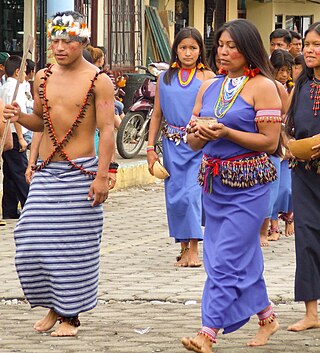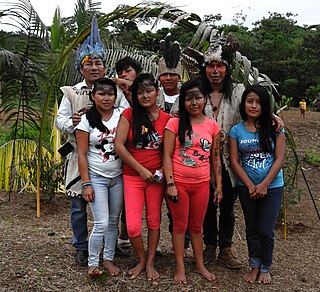Related Research Articles

Demographic features of the population of Ecuador include population density, ethnicity, education level, health of the populace, economic status, religious affiliations and other aspects of the population.

The Shuar, also known as Jivaro, are an indigenous ethnic group that inhabits the Ecuadorian and Peruvian Amazonia. They are famous for their hunting skills and their tradition of head shrinking, known as Tzantsa.

The Sápara, also known as Zápara or Záparo, are an indigenous people native to the Amazon rainforest along the border of Ecuador and Peru. They once occupied some 12,000 mi2 between the Napo River and the Pastaza. Early in the 20th century, there were some 200,000 Zapara. From the year 2009 on the Ecuadorian Zápara call themselves Sápara. The official name is Nación Sápara del Ecuador (NASE). It means Sápara Nation of Ecuador. The president of this nation is Klever Ruiz. The Sápara Nation was officially registered by CONDENPE – the Council of Development of the nationalities and peoples of Ecuador – on September 16, 2009. The current name of the organisation is the result of a unification process of upriver and downriver communities. There was a conflict between these different groups about their authentic ethnic identity in the last years of the 20th century and the beginning of the 21st century. With this unification this conflict seems to be solved. CONDENPE confirms as well officially the legal status of autonomy or self-government of the Sápara Nation of Ecuador N.A.S.E. and confirms their territory between the rivers Pindoyacu, Conambo and Alto Corrientes in the province of Pastaza. It is confirmed as well that the head office of NASE is the city of Shell, Pastaza.

Quechua people, Quichua people or Kichwa people may refer to any of the Indigenous peoples of South America who speak the Quechua languages, which originated among the Indigenous people of Peru. Although most Quechua speakers are native to Peru, there are some significant populations in Ecuador, Bolivia, Chile, Colombia, and Argentina.

Sarayaku is a territory and a village situated by the Bobonaza River in the province of Pastaza in the southern part of el Oriente, the Amazonic region of Ecuador. The territory incorporates a number of villages.

Záparo is a nearly dead language spoken by the Sápara, or Záparo, people of Ecuador. As of 2000, it was spoken by only one person out of a total population of 170 in Pastaza Province, between the Curaray and Bobonaza rivers. Záparo is also known as Zápara and Kayapwe. The members of the Záparo ethnic group now speak Quichua, though there is a language revival effort beginning. Záparo is sometimes confused with Andoa, though the two languages are distinct. Záparo has a subject–verb–object word order.
Shuar, which literally means "people", also known by such terms as Chiwaro, Jibaro, Jivaro, or Xivaro, is an indigenous language spoken by the Shuar people of Morona Santiago Province and Pastaza Province in the Ecuadorian Amazon basin.

Kichwa is a Quechuan language that includes all Quechua varieties of Ecuador and Colombia (Inga), as well as extensions into Peru. It has an estimated half million speakers.

Media Lengua, also known as Chaupi-shimiChaupi-lengua, Chaupi-Quichua, Quichuañol, Chapu-shimi or llanga-shimi, is a mixed language with Spanish vocabulary and Kichwa grammar, most conspicuously in its morphology. In terms of vocabulary, almost all lexemes (89%), including core vocabulary, are of Spanish origin and appear to conform to Kichwa phonotactics. Media Lengua is one of the few widely acknowledged examples of a "bilingual mixed language" in both the conventional and narrow linguistic sense because of its split between roots and suffixes. Such extreme and systematic borrowing is only rarely attested, and Media Lengua is not typically described as a variety of either Kichwa or Spanish. Arends et al., list two languages subsumed under the name Media Lengua: Salcedo Media Lengua and Media Lengua of Saraguro. The northern variety of Media Lengua, found in the province of Imbabura, is commonly referred to as Imbabura Media Lengua and more specifically, the dialect varieties within the province are known as Pijal Media Lengua and Angla Media Lengua.

Ilex guayusa is a species of tree of the holly genus, native to the Amazon Rainforest. One of four known caffeinated holly trees, the leaves of the guayusa tree are harvested fresh and brewed like a tea for their stimulative effects. It is known simply as guayusa in western languages like Spanish, as waisa in Kichwa and as wayus or wais in Shuar.
Bride service has traditionally been portrayed in the anthropological literature as the service rendered by the bridegroom to a bride's family as a bride price or part of one. Bride service and bride wealth models frame anthropological discussions of kinship in many regions of the world.
Carlos Antonio Vargas Guatatuca is an indigenous Quechua politician of Ecuador. He was leader of the Confederación de Nacionalidades Indígenas de Ecuador (CONAIE) and Minister for Social Welfare under president Lucio Gutiérrez from 2003 to 2005.

The Indigenous peoples of Peru or Native Peruvians comprise a large number of ethnic groups who inhabit territory in present-day Peru. Indigenous cultures developed here for thousands of years before the arrival of the Spanish in 1532.

Puyo, also known as El Puyo, is the capital of Pastaza, a province in Ecuador. Puyo is located at an altitude of approximately 950 metres above sea level by the Puyo River, a tributary of the Pastaza River, which eventually leads into the Amazon River. True to its name, derived from the Kichwa word for "cloudy", the local climate is a wet one and the weather is often overcast.
Canelos is a rural parish of the canton of Pastaza, in the province of Pastaza. It is located to the southeast of the city of Puyo.

Amazonian Kichwas are a grouping of indigenous Kichwa peoples in the Ecuadorian Amazon, with minor groups across the borders of Colombia and Peru. Amazonian Kichwas consists of different ethnic peoples, including Napo Kichwa and Canelos Kichwa. There are approximately 419 organized communities of the Amazonian Kichwas. The basic socio-political unit is the ayllu. The ayllus in turn constitute territorial clans, based on common ancestry. Unlike other subgroups, the Napo Kichwa maintain less ethnic duality of acculturated natives or Christians.
Janis Nuckolls is an American anthropological linguist and professor of linguistics and English language at Brigham Young University in Provo, Utah. She has spent many years doing field research, with a primary focus on the Amazonian Quichua (Kichwa) people in Ecuador and their endangered language.
Norman E. Whitten, Jr. is an American cultural anthropologist who is Professor Emeritus of Anthropology and Latin American Studies at the University of Illinois Urbana-Champaign, and Curator of the Spurlock Museum of World Cultures. He is known for books based on his anthropological field work and his research on the Afro-Latin and Indigenous peoples of the West Coast rainforest and upper Amazon Rain forest, most notably the Black population and Canelos Quichua and Achuar Peoples.
References
- ↑ Whitten, Norman E. (December 1, 1978). "Ecological Imagery and Cultural Adaptability: The Canelos Quichua of Eastern Ecuador". American Anthropologist. 80 (4): 836–859. doi:10.1525/aa.1978.80.4.02a00040 . Retrieved November 10, 2024.
- ↑ Whitten, Norman E.; Whitten, Dorothea S. (1984). ESSAY: The structure of kinship and marriage among the Canelos Quichua of east-central Ecuador - in: In Marriage Practices in Lowland South America. University of Illinois Press. pp. 194–220, 265–283. Retrieved November 10, 2024.
- ↑ Whitten, Norman E.; Whitten, Dorothea S. (1978). "Ceramics of the Canelos Quichua". Natural History. 87 (8): 90–99. Retrieved November 10, 2024.